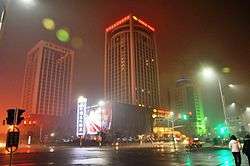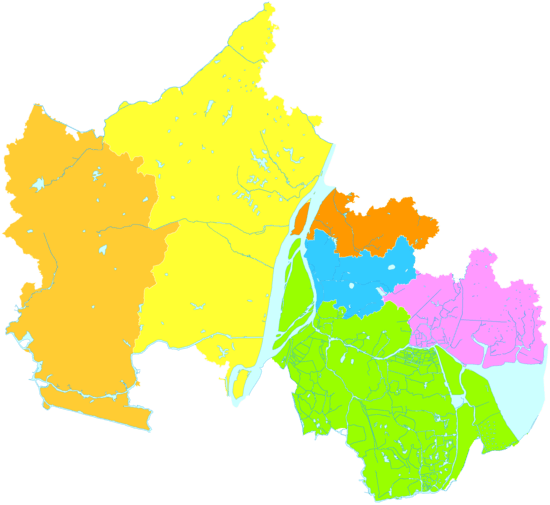Ma'anshan
Ma'anshan (simplified Chinese: 马鞍山; traditional Chinese: 馬鞍山; pinyin: Mǎ'ānshān), also colloquially written as Maanshan, is a prefecture-level city in the eastern part of Anhui province in Eastern China. An industrial city stretching across the Yangtze River, Ma'anshan borders Hefei to the west, Wuhu to the southwest, and Nanjing to the east. It is a satellite city of the Nanjing metropolitan area and is also a city in the Yangtze River Delta Economic Zone.
Ma'anshan 马鞍山市 Maanshan | |
|---|---|
 | |
.png) Location of Ma'anshan City jurisdiction in Anhui | |
| Coordinates (Ma'anshan municipal government): 31°40′08″N 118°30′25″E | |
| Country | People's Republic of China |
| Province | Anhui |
| County-level divisions | 6 |
| Township-level divisions | 49 |
| Municipal seat | Yushan District |
| Government | |
| • CPC Secretary | Zheng Weiwen (郑为文) |
| • Mayor | Zhang Xiaolin (张晓麟) |
| Area | |
| • Prefecture-level city | 4,042 km2 (1,561 sq mi) |
| • Urban | 340 km2 (130 sq mi) |
| • Metro | 1,686 km2 (651 sq mi) |
| Population (2010 census) | |
| • Prefecture-level city | 2,202,899 |
| • Density | 550/km2 (1,400/sq mi) |
| • Urban | 741,531 |
| • Urban density | 2,200/km2 (5,600/sq mi) |
| • Metro | 1,366,302 |
| • Metro density | 810/km2 (2,100/sq mi) |
| Time zone | UTC+8 (China Standard) |
| Postal code | 243000 |
| Area code(s) | 555 |
| ISO 3166 code | CN-AH-05 |
| GDP | ¥136.5 billion (2015) |
| GDP per capita | US$9,834 (2015) |
| License Plate Prefix | 皖E |
As of the 2010 census, Ma'anshan was home to 2,202,899 inhabitants, of whom 1,366,302 lived in the built-up area made of three urban districts and Dangtu County, which is largely urbanized.[1] After the August 2011 administrative re-regionalization of Anhui Province, its population rose to 2.20 million, as two additional counties (He and Hanshan) were placed under its administration.
Administration
The prefecture-level city of Ma'anshan administers 6 county-level divisions, including 3 districts and 3 counties.
- Yushan District (雨山区)
- Huashan District (花山区)
- Bowang District (博望区)
- Dangtu County (当涂县)
- He County (和县)
- Hanshan County (含山县)
In September 2012, Jinjiazhuang District was dissolved and merged with Huashan District, while part of Dangtu County was split and established as Bowang District.
| Map | |||||
|---|---|---|---|---|---|
Name
The name of the city means "Horse Saddle Mountain". According to legend, the name came to be when the Western Chu hegemon Xiang Yu was fleeing from the Battle of Gaixia. Rather than be captured, the defeated general killed himself at the area now known as Ma'anshan after ensuring that his beloved horse would be ferried across the river to safety. Upon seeing his master die, the grief-stricken horse leapt into the river and was drowned. As a tribute, the boatman buried the horse's saddle on a nearby hill, giving Ma'anshan its name.
History
The south bank of the Yangtze River from Ma'anshan upstream for 240 km (150 mi), has long been a mining area. The coming of a railroad and the opening of the Huai-nan coalfield in the 1930s made it possible for the Japanese to open an iron and steel works in 1938. Although destroyed at the end of the Second World War, the industries were restored to production in 1953, and Ma'anshan grew rapidly under the Communists' first and second Five-Year Plans. Ma'anshan also has sulfur and limestone mines, and chemical and cement factories. In 1954, Ma'anshan was elevated to town level, and, in Oct. 12, 1956, Ma'anshan City was declared to be founded.
Geography and climate
Surrounded by low hills (the name of the city means "horse saddle mountain"), Ma'anshan is not as polluted as other major Chinese steelmaking cities, thanks to the environmental policies taken by the local government that granted the city the recognition as one of the "Ten Green Cities of China."
Its climate is similar to other cities in the Yangtze River Delta, with lower humidity that makes its summers and winters less extreme. There are frequent showers during July and August.
Caishi Rock (采石矶; 采石磯), a famous ancient battlefield from the Jin–Song Wars lying to the southwest of the city, is regarded as the best of three rocks that project over the Yangtze River.[2] Taibai pavilion is one of four famous pavilions along the Yangtze river. Caishi scenic area is a national tourism spot, with a combination of natural and man-made scenery.
| Climate data for Ma'anshan (1981−2010 normals) | |||||||||||||
|---|---|---|---|---|---|---|---|---|---|---|---|---|---|
| Month | Jan | Feb | Mar | Apr | May | Jun | Jul | Aug | Sep | Oct | Nov | Dec | Year |
| Average high °C (°F) | 7.3 (45.1) |
9.5 (49.1) |
14.3 (57.7) |
20.8 (69.4) |
26.4 (79.5) |
29.2 (84.6) |
32.4 (90.3) |
31.8 (89.2) |
27.8 (82.0) |
22.6 (72.7) |
16.3 (61.3) |
10.0 (50.0) |
20.7 (69.2) |
| Daily mean °C (°F) | 3.2 (37.8) |
5.4 (41.7) |
9.7 (49.5) |
16.0 (60.8) |
21.5 (70.7) |
25.1 (77.2) |
28.5 (83.3) |
27.7 (81.9) |
23.5 (74.3) |
18.0 (64.4) |
11.6 (52.9) |
5.6 (42.1) |
16.3 (61.4) |
| Average low °C (°F) | 0.1 (32.2) |
2.1 (35.8) |
6.0 (42.8) |
11.8 (53.2) |
17.3 (63.1) |
21.6 (70.9) |
25.3 (77.5) |
24.6 (76.3) |
20.2 (68.4) |
14.3 (57.7) |
7.9 (46.2) |
2.1 (35.8) |
12.8 (55.0) |
| Average precipitation mm (inches) | 47.9 (1.89) |
56.7 (2.23) |
92.0 (3.62) |
90.0 (3.54) |
98.3 (3.87) |
165.3 (6.51) |
202.5 (7.97) |
144.5 (5.69) |
66.3 (2.61) |
57.9 (2.28) |
59.8 (2.35) |
32.8 (1.29) |
1,114 (43.85) |
| Average relative humidity (%) | 74 | 73 | 72 | 71 | 71 | 76 | 79 | 81 | 78 | 74 | 73 | 71 | 74 |
| Source: China Meteorological Administration[3] | |||||||||||||
Economy
The main industry is the steel industry (MaGang) which employs much of the workforce of Ma'anshan. At present (2005) major expansions of the steel plant are underway to increase production drastically. With the advanced manufacturing infrastructure and fast transportation link, Ma'anshan has received much investment in many industries.
Ma'anshan city has an annual manufacture investment ranking No.1 in Anhui Province and her GDP ranks No.4 in Anhui Province after Hefei, Anqing and Wuhu. Ma'anshan's population ranks No.16 in the province and has a GDP per capita of US$7,118 which is No.1 in Anhui Province and near the average of Yangtze River Delta.
Maanshan has been identified by the Economist Intelligence Unit in the November 2010 Access China White Paper as a member of the CHAMPS (Chongqing, Hefei, Anshan, Ma'anshan, Pingdingshan and Shenyang), an economic profile of the top 20 emerging cities in China.[4]
Transportation
The deep water river port of Ma'anshan, with custom offices ensures fast and inexpensive transportation to other cities both in the East coast, and the inner cities along the Yangtze River. Nanjing Lukou International Airport is 40 km (25 mi) from Ma'anshan, with direct flights to every corner of China and also daily flights to Europe. By road, Ma'anshan is connected with highways to Nanjing, Shanghai, Hangzhou, Ningbo, Hefei and Wuhu.
The city has one Yangtze River crossing—the Ma'anshan Yangtze River Bridge, opened in 2013, enables direct road access to cities in northern Anhui.
Culture
There is a memorial to the famous Chinese poet, Li Bai (a.k.a. Li Po c.700-762), just west of Ma'anshan. Li Bai is said to have drowned at Ma'anshan after attempting to embrace a reflection of the moon.
China's first poetry festival was held in Ma'anshan from October 25–30, 2005. The theme of the festival, sponsored by the Ministry of Culture, the Chinese Writers Association, and the Anhui provincial government, was "Poetic China, Harmonious China."
Education
- Anhui University of Technology
- Hohai University Wentian College which is a high institute mainly focus in trading and business management, and expanding to offer the international bachelor's degree for several majors bilingually in English and Chinese.
References
- http://www.citypopulation.de/php/china-anhui-admin.php
- 长江三大名矶 [The Three Great Rocks in the Yangtze]. 博雅旅游分享网 (in Chinese). Retrieved 30 December 2017.
采石矶,又名牛渚矶,居我国著名的“长江三矶”之首。
- 中国气象数据网 - WeatherBk Data (in Chinese). China Meteorological Administration. Retrieved 2020-04-12.
- THE RISE OF THE ‘CHAMPS’ - NEW REPORT MAPS BUSINESS OPPORTUNITY IN CHINA’S FASTEST GROWING CITIES

